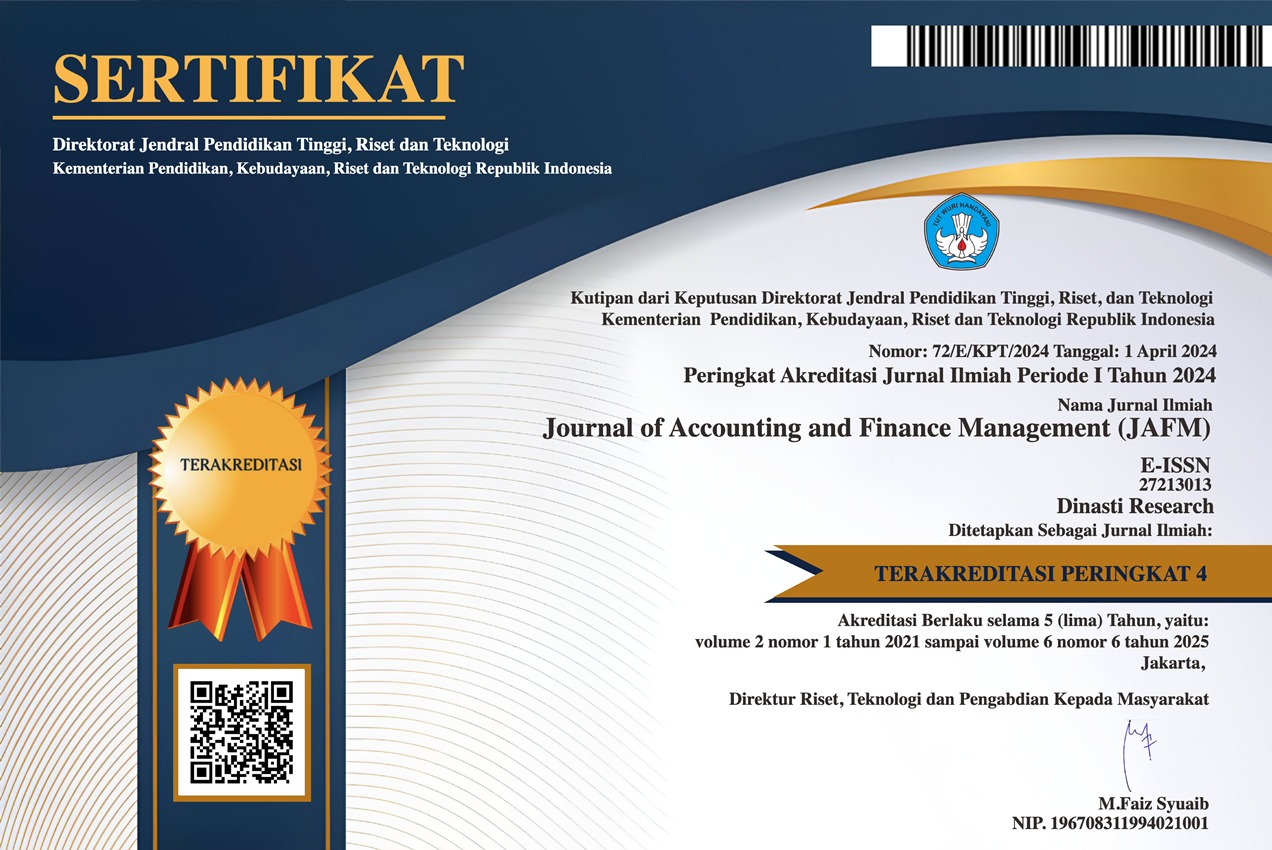The Role of ESG Component in Shaping Corporate Cost of Debt and Cost of Equity in Indonesia
DOI:
https://doi.org/10.38035/jafm.v5i6.1241Keywords:
ESG, Cost of Debt, Cost of Equity, Sustainable Finance, Indonesian CompaniesAbstract
This study aims to analyze how the ESG combined score and its components affect the cost of debt and equity for listed companies in Indonesia. Otoritas Jasa Keuangan (OJK) has issued regulations to encourage the inclusion of companies' ESG performance in investment decisions. This has resulted in companies getting incentives to improve their ESG performance. However, the actual impact of lower capital costs due to improved ESG performance is still unavailable in Indonesia. This study attempts to fill this gap by considering the impact of the assessment of the components that underlie ESG values: emission reduction, resource use, environmental innovation, workforce, community, human rights, product responsibility, CSR strategy, management, and shareholder rights on the cost of debt and equity. The results show the ESG combined score has no impact on the cost of debt. However, components such as emissions, environmental innovation, and human rights can directly affect the company's debt cost. In addition, the results show that the combined ESG score and almost all components that build the ESG score affect the company's equity cost. However, this study found that the majority had a positive relationship with heavy-polluting companies and a negative relationship with non-heavy-polluting companies.
References
Alves, C. F., & Meneses, L. L. (2024). ESG scores and debt costs: Exploring indebtedness, agency costs, and financial system impact. International Review of Financial Analysis, 94. https://doi.org/10.1016/j.irfa.2024.103240
Amarna, K., Garde Sánchez, R., López-Pérez, M. V., & Marzouk, M. (2024). The effect of environmental, social, and governance disclosure and real earning management on the cost of financing. Corporate Social Responsibility and Environmental Management, 31(4), 3181–3193. https://doi.org/10.1002/csr.2740
Apergis, N., Poufinas, T., & Antonopoulos, A. (2022). ESG scores and cost of debt. Energy Economics, 112. https://doi.org/10.1016/j.eneco.2022.106186
Asimakopoulos, P., Asimakopoulos, S., & Li, X. (2023). The role of environmental, social, and governance rating on corporate debt structure. Journal of Corporate Finance, 83. https://doi.org/10.1016/j.jcorpfin.2023.102488
Chen, Y., Li, T., Zeng, Q., & Zhu, B. (2023). Effect of ESG performance on the cost of equity capital: Evidence from China. International Review of Economics and Finance, 83, 348–364. https://doi.org/10.1016/j.iref.2022.09.001
Das, P. (2019). Econometrics in theory and practice: Analysis of cross section, time series and panel data with stata 15.1. Springer Singapore. https://doi.org/10.1007/978-981-32-9019-8
Deegan, C., Rankin, M., & Tobin, J. (2002). An examination of the corporate social and environmental disclosures of BHP from 1983-1997: A test of legitimacy theory. Accounting, Auditing & Accountability Journal, 15(3), 312–343. https://doi.org/10.1108/09513570210435861
Ernst, D., & Woithe, F. (2024). Impact of the Environmental, Social, and Governance Rating on the Cost of Capital: Evidence from the S&P 500. Journal of Risk and Financial Management, 17(3). https://doi.org/10.3390/jrfm17030091
Freeman, R. E. (1999). Divergent Stakeholder Theory. Academy of Management Review, 24(2), 233–236.
Gracia, O., & Siregar, S. V. (2021). Sustainability practices and the cost of debt: Evidence from ASEAN countries. Journal of Cleaner Production, 300. https://doi.org/10.1016/j.jclepro.2021.126942
Gujarati, D. N. (2003). Basic Econometrics Fourth Edition. www.mhhe.com
Koczar, J., Zakhmatov, D., & Vagizova, V. (2023). Tools for considering ESG factors in business valuation. Procedia Computer Science, 225, 4245–4253. https://doi.org/10.1016/j.procs.2023.10.421
Lavin, J. F., & Montecinos-Pearce, A. A. (2022). Heterogeneous Firms and Benefits of ESG Disclosure: Cost of Debt Financing in an Emerging Market. Sustainability (Switzerland), 14(23). https://doi.org/10.3390/su142315760
Li, W., Hu, H., & Hong, Z. (2024). Green finance policy, ESG rating, and cost of debt——Evidence from China. International Review of Financial Analysis, 92. https://doi.org/10.1016/j.irfa.2023.103051
Mátyás, L., & Sevestre, P. (2008). The Econometrics of Panel Data Fundamentals and Recent Developments in Theory and Practice. Springer.
National Commission Human Rights. (2024). Pandangan Komnas HAM tentang Pembangunan Berkelanjutan, Lingkungan Hidup Energi, Pangan dan Agraria dalam Rangka Debat Calon Wakil Presiden. www.komnasham.go.id
PWC. (2023, September 5). Tren dan Arah Sustainability Report Indonesia di Masa Mendatang. Retrieved from https://www.pwc.com/id/en/media-centre/press-release/2023/indonesian/tren-dan-arah-sustainability-report-indonesia-di-masa-mendatang.html
Rifqi Satria Dinanda, & Zuliani Dalimunthe. (2024). The Impact of Debt Rating Mediation on ESG Scores and Corporate Debt Costs in Indonesia for the Period 2018-2023. Dinasti International Journal of Economics, Finance and Accounting (DIJEFA), 5(3). https://doi.org/10.38035/dijefa.v5i3
Shapiro, S. P. (2005). Agency theory. Annual Review of Sociology, 31, 263–284. https://doi.org/10.1146/annurev.soc.31.041304.122159
Shi, Y., Zheng, S., Xiao, P., Zhen, H., & Wu, T. (2024). ESG performance and cost of debt. China Journal of Accounting Research. https://doi.org/10.1016/j.cjar.2024.100390
Downloads
Published
How to Cite
Issue
Section
License
Copyright (c) 2025 Jasmine Hanna Pramadhia, Yunieta Anny Nainggolan

This work is licensed under a Creative Commons Attribution 4.0 International License.
Authors who publish their manuscripts in this journal agree to the following conditions:
- The copyright on each article belongs to the author(s).
- The author acknowledges that the Journal of Accounting and Finance Management (JAFM) has the right to be the first to publish with a Creative Commons Attribution 4.0 International license (Attribution 4.0 International (CC BY 4.0).
- Authors can submit articles separately, arrange for the non-exclusive distribution of manuscripts that have been published in this journal into other versions (e.g., sent to the author's institutional repository, publication into books, etc.), by acknowledging that the manuscript has been published for the first time in the Journal of Accounting and Finance Management (JAFM).



























